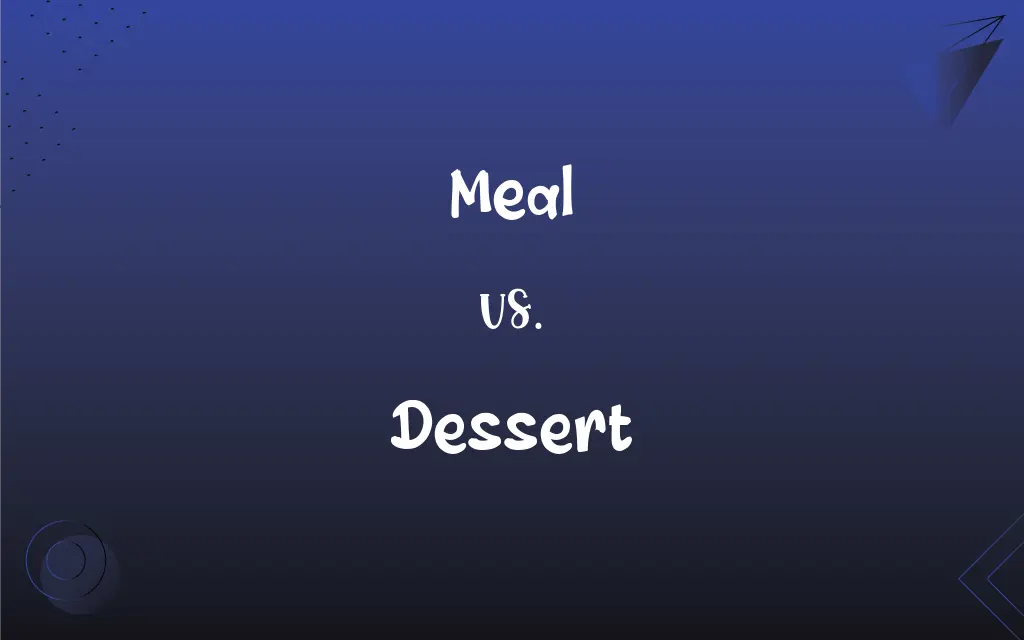Meal vs. Dessert: What's the Difference?
By Janet White & Harlon Moss || Updated on March 4, 2024
Meal and dessert differ primarily in their role in dining: a meal is the main part of dining, often consisting of multiple courses, while dessert is a sweet course that concludes a meal.

Key Differences
Meals are the primary eating occasions that include breakfast, lunch, and dinner, consisting of various dishes aimed at providing nutrition and satiety. They can range from simple dishes to elaborate multi-course spreads and are integral to daily dietary routines. On the other hand, desserts are typically sweet foods or dishes served after the main meal courses, designed to provide a pleasant conclusion to the meal. Desserts can include a wide range of items such as cakes, cookies, ice cream, and fruit, and are often associated with indulgence and celebration.
While meals are essential for nutritional balance and energy, providing the body with necessary nutrients through a variety of ingredients and dishes, desserts are often considered an optional part of dining, focusing more on taste and indulgence rather than nutritional value. Meals are characterized by their diversity, including proteins, carbohydrates, and vegetables, whereas desserts are primarily defined by their sweetness, often featuring sugar, chocolate, fruits, and other sweetening agents.
Cultural and personal preferences greatly influence the composition and timing of meals and desserts. Meals can vary widely across different cultures in terms of ingredients, cooking methods, and eating practices, reflecting regional dietary habits and traditions. Desserts, while universally present in some form, also exhibit significant cultural variation, from rich, creamy pastries in some cultures to fruit-based light desserts in others.
In terms of health and dietary considerations, meals are central to discussions about balanced diets, nutritional intake, and healthful eating practices. Desserts, due to their typical sugar and fat content, are often subjects of moderation within a diet, linked to indulgence and sometimes to unhealthy eating habits when consumed in excess.
Comparison Chart
Definition
Main eating occasion, often consisting of multiple courses aimed at nutrition and satiety.
Sweet course concluding a meal, focused on taste and indulgence.
ADVERTISEMENT
Components
Can include proteins, vegetables, grains, and more, aimed at providing a balanced diet.
Primarily sweet ingredients like sugar, fruits, chocolate.
Nutritional Value
High, as meals are designed to provide essential nutrients and energy.
Often lower, with a focus on taste over nutritional content.
Cultural Variation
Significant, with meals reflecting regional dietary habits and traditions.
Present, with desserts varying widely across cultures but often centered around sweetness.
Health Considerations
Central to discussions on balanced diets and nutritional intake.
Often associated with moderation due to sugar and fat content.
Meal and Dessert Definitions
Meal
The main dietary intake period, often taking place at specific times.
Lunch is the midday meal for many cultures.
ADVERTISEMENT
Dessert
A sweet course concluding a meal.
For dessert, we had chocolate cake.
Meal
A social or ceremonial gathering around food.
The wedding meal featured a three-course menu.
Dessert
Can range from baked goods to frozen treats.
Ice cream is a popular dessert during summer.
Meal
A structured eating occasion typically consisting of multiple food items.
For dinner, the meal included grilled chicken, steamed vegetables, and rice.
Dessert
Often associated with indulgence and celebration.
Birthday parties often feature a special dessert.
Meal
An essential part of daily routine for nutrition.
Skipping a meal can affect your energy levels.
Dessert
Sometimes served as a treat or reward.
Dessert was offered as a reward for finishing homework.
Meal
The edible whole or coarsely ground grains of a cereal grass.
Dessert
Reflects cultural traditions and preferences.
In Italy, gelato is a common dessert choice.
Meal
A granular substance produced by grinding.
Dessert
A usually sweet course or dish, as of fruit, ice cream, or pastry, served at the end of a meal.
Meal
The food served and eaten in one sitting.
Dessert
Chiefly British Fresh fruit, nuts, or sweetmeats served after the sweet course of a dinner.
Meal
A customary time or occasion of eating food.
Dessert
The last course of a meal, consisting of fruit, sweet confections etc.
I ordered hummus for a starter, a steak as the main course, and chocolate cake for dessert.
Can I see the dessert menu, please?
Meal
Move Middle English to an Middle English (enm) entry
Dessert
A sweet dish or confection served as the last course of a meal.
Trifle is a favourite dessert of the English, but rivalled by pavlova in Australia and New Zealand.
Meal
Possible search real New English citations for obsolete senses}}
Dessert
A service of pastry, fruits, or sweetmeats, at the close of a feast or entertainment; pastry, fruits, etc., forming the last course at dinner.
"An 't please your honor," quoth the peasant,"This same dessert is not so pleasant."
Meal
(countable) Food that is prepared and eaten, usually at a specific time, and usually in a comparatively large quantity (as opposed to a snack).
Breakfast is the morning meal, lunch is the noon meal, and dinner, or supper, is the evening meal.
Dessert
A dish served as the last course of a meal
Meal
(countable) Food served or eaten as a repast.
Meal
A break taken by a police officer in order to eat.
Meal
(obsolete) A time or an occasion.
Meal
The coarse-ground edible part of various grains often used to feed animals; flour or a coarser blend than flour.
Meal
A speck or spot.
Meal
A part; a fragment; a portion.
Meal
To yield or be plentiful in meal.
Meal
(transitive) To defile or taint.
Meal
A part; a fragment; a portion.
Meal
The portion of food taken at a particular time for the satisfaction of appetite; the quantity usually taken at one time with the purpose of satisfying hunger; a repast; the act or time of eating a meal; as, the traveler has not eaten a good meal for a week; there was silence during the meal.
What strange fishHath made his meal on thee?
Meal
Grain (esp. maize, rye, or oats) that is coarsely ground and unbolted; also, a kind of flour made from beans, pease, etc.; sometimes, any flour, esp. if coarse.
Meal
Any substance that is coarsely pulverized like meal, but not granulated.
Meal
To sprinkle with, or as with, meal.
Meal
To pulverize; as, mealed powder.
Meal
The food served and eaten at one time
Meal
Any of the occasions for eating food that occur by custom or habit at more or less fixed times
Meal
Coarsely ground foodstuff; especially seeds of various cereal grasses or pulse
Meal
A provision of food served at one time.
The camp provided a hearty meal for all the hikers.
FAQs
How do cultural preferences influence meals and desserts?
Cultural preferences greatly influence the ingredients, preparation, and timing of meals and desserts, reflecting regional dietary habits and traditions.
What types of foods are typically considered desserts?
Desserts typically include sweet foods such as cakes, cookies, ice cream, and fruit.
What defines a meal?
A meal is defined as a primary eating occasion consisting of one or more food items aimed at providing nutrition and satiety.
How do meals contribute to nutritional health?
Meals contribute to nutritional health by providing the body with essential nutrients through a variety of ingredients and dishes.
Can a dessert be part of a meal?
Yes, a dessert is traditionally served as the final course of a meal.
Are desserts necessary for a balanced diet?
Desserts are not necessary for a balanced diet and are often consumed in moderation due to their sugar and fat content.
Is it common to have multiple meals a day?
Yes, it's common to have multiple meals a day, typically including breakfast, lunch, and dinner.
How does the timing of meals and desserts vary across cultures?
The timing of meals and desserts varies significantly across cultures, with differences in meal times, frequency, and the traditional time for serving desserts.
What role do meals play in social gatherings?
Meals often serve as a focal point for social gatherings, celebrations, and ceremonies, facilitating social interaction and bonding.
What role do seasonal ingredients play in meals and desserts?
Seasonal ingredients play a significant role in meals and desserts by influencing flavors, availability, and the traditional dishes prepared during different times of the year.
Can desserts be healthy?
Desserts can be made healthier by using ingredients lower in sugar and fat, and incorporating fruits and other nutritious elements.
Do all cultures serve dessert after meals?
While serving dessert after meals is common, the practice and type of dessert can vary significantly across cultures.
Can a meal consist of only a dessert?
While not typical or recommended for nutritional balance, a meal can consist of only a dessert, especially in casual or unconventional dining situations.
What are some common dietary restrictions that affect meal and dessert choices?
Common dietary restrictions affecting meal and dessert choices include allergies, vegetarianism, veganism, religious dietary laws, and health-related restrictions like diabetes.
What is the significance of dessert in a dining experience?
Dessert holds significance in a dining experience as a pleasurable conclusion, often enhancing the overall satisfaction and providing a sense of completion to the meal.
How do portion sizes vary between meals and desserts?
Portion sizes for meals are generally larger to provide adequate nutrition and energy, while dessert portions are typically smaller, focusing on taste and indulgence.
Are there specific utensils or serving dishes used for desserts?
Yes, specific utensils and serving dishes, such as dessert forks, spoons, plates, and bowls, are often used for desserts to accommodate their varied textures and presentations.
How can dietary needs be accommodated in meals and desserts?
Dietary needs can be accommodated in meals and desserts by modifying recipes, substituting ingredients, and offering a variety of options to cater to different restrictions and preferences.
How do convenience and fast foods impact traditional meal and dessert structures?
Convenience and fast foods can impact traditional meal and dessert structures by altering eating patterns, reducing meal preparation time, and sometimes prioritizing speed and ease over nutritional balance.
How have meals and desserts evolved over time?
Meals and desserts have evolved over time due to factors like globalization, changing dietary trends, and innovations in food preparation and preservation.
About Author
Written by
Janet WhiteJanet White has been an esteemed writer and blogger for Difference Wiki. Holding a Master's degree in Science and Medical Journalism from the prestigious Boston University, she has consistently demonstrated her expertise and passion for her field. When she's not immersed in her work, Janet relishes her time exercising, delving into a good book, and cherishing moments with friends and family.
Co-written by
Harlon MossHarlon is a seasoned quality moderator and accomplished content writer for Difference Wiki. An alumnus of the prestigious University of California, he earned his degree in Computer Science. Leveraging his academic background, Harlon brings a meticulous and informed perspective to his work, ensuring content accuracy and excellence.































































